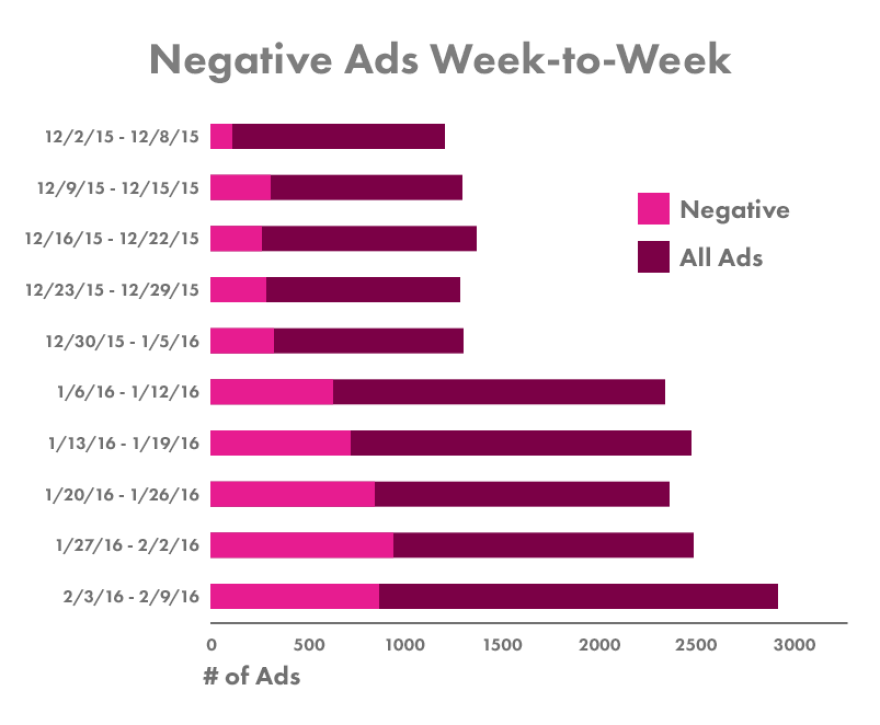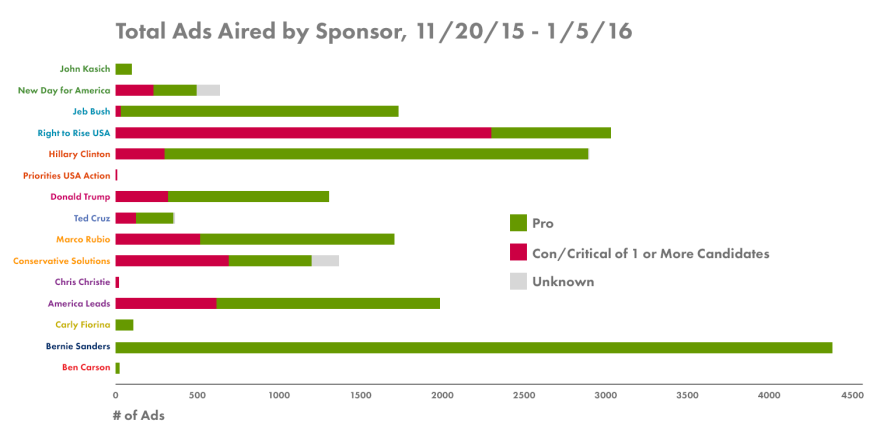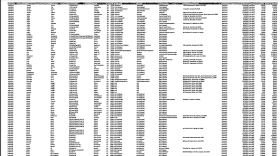With the 2016 presidential campaign now entrenched in Nevada and South Carolina, local television stations are closing the books on the New Hampshire Primary.
This year's race saw some ground-breaking work in the use of digital ads to reach potential voters. But old-fashioned TV spots still played a big role in the 2016 persuasion war. Final invoices are still trickling in, but here’s a quick review of how the race played out on Granite State televisions over the past year.
Super PACs played little, if any, role in the outcome.
Since last April, when a Super PAC backing George Pataki booked the first round of ads on WMUR, more than 45,000 political commercials aired on 14 stations in three regional markets: Boston/Manchester, Burlington, Vt., and Portland, Me. Just shy of $75 million was spent on behalf of 13 candidates, or $139 for each of the 538,094 votes cast this year.
But it was clear by the fall that ad spending was not paying off for the biggest spenders, the various super PACs set up to support Republican candidates.
More than $2 of every $3 spent on political ads before the primary came from a Super PAC. But none of the 10 groups involved in the GOP race backed the winner, Donald Trump -- who, of course, let it be known he didn’t want or need the help.

On the Democratic side, Bernie Sanders, another PAC-less candidate, focused his early spending on a digital media strategy, giving Hillary Clinton a three-month head start on TV. The Vermont senator did outspend Clinton on the air in the final weeks of the New Hampshire campaign. But, by that point, he had a comfortable lead in the polls and the splurge was probably unnecessary.
Jeb Bush saw the worst return on investment.
Between his campaign and the super PAC Right to Rise, Jeb Bush had more than $155 million in financial support going into the primary. In New Hampshire, the campaign and the PAC committed a combined $25 million to TV ads, or $1 of every $3 spent this year.
It wasn't money well spent. Bush managed a fourth-place finish, just ahead of Marco Rubio, with 31,310 votes. That works out to $752 for every ballot cast his way.

Moreover, only 30 percent of the 9,600 ads that backed Bush ran on WMUR and WBIN, the two stations that serve New Hampshire. More than three-quarters of his primary ad budget was spent on four Boston network affiliates, whose rates are considerably higher. That means some $19 million was directed largely toward viewers who can’t vote in New Hampshire. And at the rate his campaign is going, Bush may not even be in the race when the Bay State holds its March 1 primary.
The biggest winners were the Boston TV stations.
In 2008, the last time both parties had competitive presidential primaries, two-thirds of all ads in the Boston/Manchester market ran on WMUR. However, that was two years before the Supreme Court opened the door to outside groups with its Citizens United ruling.
This year, thanks to the additional tens of millions of dollars poured into the race by super PACs, more than 4 of every 10 ads ran on the Boston affiliates. The four stations took in more than $42 million, or well over half the amount spent by campaigns and outside groups.
Not that anyone should feel bad for WMUR. The station sold $28 million in primary-related ads, more than twice as much as it did in 2008.
Consistency helps.
To the extent that TV ads had any an effect on voter preferences this year, both Sanders and Trump may have benefited from a more cohesive message.
Sanders aired more than 20 distinct ads between early November and Primary Day, according to Political TV Ad Archive, which documents ads running in key primary states. That catalogue includes a standard biographical ad recapping his political career. The rest touched on a handful of broad issues – health care, campaign finance, government regulations – while at the same time underscoring Sanders’ core campaign theme of a rigged economy controlled by a corrupt political establishment.
Clinton had a different challenge, namely making sense of her experiences as advocate, first lady, senator, secretary of state and, not least, victim of a “vast right-wing conspiracy.” Accordingly, her 19 different ads covered equal pay for women, gun control, foreign policy, human rights, education, the economy, health care, terrorism and so on.
Trump, who didn’t start advertising in New Hampshire until mid-December, aired five different ads in New Hampshire. Three, including one that attacked Ted Cruz, dealt almost exclusively with immigration and Trump’s promise to build a wall between the U.S. and Mexico. They all, however, left the viewer with the same impression: Donald Trump speaks his mind unlike anyone else in the race
The GOP race grew increasingly nasty.
Through the summer and fall, the campaign was almost entirely positive, and it would stay that way to the end on the Democratic side. Among Republicans, things started to change the second week of December, when the number of negative ads tripled to nearly a quarter of the total aired.
Making sense of the myriad attacks took special attention to the dynamics of the race, which for everyone but Trump had come down to establishing a legitimate reason for carrying on past New Hampshire.

So you had Conservative Solutions, the super PAC supporting Rubio, attacking Chris Christie for expanding Medicaid in New Jersey and cozying up to President Obama. Christie's super PAC backers, America Leads, kept its eyes largely on Hillary Clinton, although his campaign felt compelled to air an ad critical of Rubio on immigration. New Day for America, a group backing John Kasich, took on Trump, Rubio and Bush for, among other things, negative campaigning.
By the final weeks, no less than 50 different attack ads had aired, according to Political TV Ad Archive, with Right to Rise by far slinging the most mud. No one was subjected to more negativity than Marco Rubio, who was at the center of eight separate attack ads by the super PAC.
But the group was critical of nearly every candidate at one point or another: 75 percent of its ads were negative.








